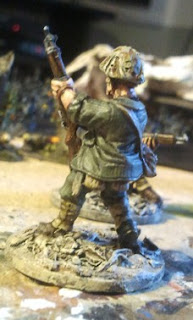Last friday night at The Club we enjoyed a very though naval engagement, between my British Home Fleet and W.'s Hochseeflotte...
We did it with Naval Thunder: Clash of Dreadnoughts (http://navalthunder.com/), a ruleset we really like for WWI sea wargaming, and GHQ 1/2400 micronauts range (and I really do not have to tell you how beautiful are these models).
It is amazing to see how fluid and challenging could be a naval battle with miniatures.
we started on the short end of our sea table, 2 division each side, mine formed by a battleships division (BB Queen Elizabeth, Ajax and the old and slow King Edward VII) supported by 3 Light Cruisers (CL Waymounth, Bristol and Aurora) and a Battlecuisers division formed by 3 Battlecruisers (BC Lion, Tiger and Inflexible) flanked by a single Armoured Cruiser (Good Hope) and a Destroyers Flottilla. on the other side the Huns fielded 2 Battleship, 3 Battlecruisers, 3 Lightcruisers and 2 Flottillas of Destroyers.
Then we had 2 fast turns of manouvering in order to achive a good firing angle, and after another turn to close the ranges, we started to hammering targets with steel...
In a naval wargame you have to consider a lot of factor when moving your units: formation and division's coherence, firing ranges and target bearing. Not last you have to keep and eye opened every move to avoid torpedoes... and that was our game. Simultaneously planned moves, trying to keep targets under range with as many turrets was possible and trying to guess were those damned destroyers were heading to.
The outcome, after 3-4 hours of funny hits and miss on the Critical Hit table, was... well... unsatisfactory. but quite historical too: a Draw. a lot of minor unit losts (I've lost my destroyers and most of my light cruisers and, on the other side, both destroyer's flottillase were sunk and only a single cruiser could head home safely) but all the main units were sailing home safely (with some scratches...).
I do not count this result as a fault in the rules. they are clever and well written, fun, simple to manage and to play, with a lot (really a lot) of suspence on each "critical hit" roll and they are absoluting more on the simulation side, with a lot of details to consider when moving or firing... (the only minus, IMHO, is the 90° turning angle... I really cannot swallow it).
The problem is hidden in the period.
During WWI, sea battles were maily draws, ending with both sides performing "strategical withdrawals". So, with these rules simulating so neatly every (or almost every) factor of a WWI naval engagement, you have to consider as a major victory when you can blow up a capital ship or a new Battlecruiser, a draw when both fleets head home with all the big ships still afloat.
Maybe, WWI naval wargaming can be fully enjoyed only with a campaign setted, where you have to consider each loss on a prospective.
We did it with Naval Thunder: Clash of Dreadnoughts (http://navalthunder.com/), a ruleset we really like for WWI sea wargaming, and GHQ 1/2400 micronauts range (and I really do not have to tell you how beautiful are these models).
It is amazing to see how fluid and challenging could be a naval battle with miniatures.
we started on the short end of our sea table, 2 division each side, mine formed by a battleships division (BB Queen Elizabeth, Ajax and the old and slow King Edward VII) supported by 3 Light Cruisers (CL Waymounth, Bristol and Aurora) and a Battlecuisers division formed by 3 Battlecruisers (BC Lion, Tiger and Inflexible) flanked by a single Armoured Cruiser (Good Hope) and a Destroyers Flottilla. on the other side the Huns fielded 2 Battleship, 3 Battlecruisers, 3 Lightcruisers and 2 Flottillas of Destroyers.
Then we had 2 fast turns of manouvering in order to achive a good firing angle, and after another turn to close the ranges, we started to hammering targets with steel...
In a naval wargame you have to consider a lot of factor when moving your units: formation and division's coherence, firing ranges and target bearing. Not last you have to keep and eye opened every move to avoid torpedoes... and that was our game. Simultaneously planned moves, trying to keep targets under range with as many turrets was possible and trying to guess were those damned destroyers were heading to.
The outcome, after 3-4 hours of funny hits and miss on the Critical Hit table, was... well... unsatisfactory. but quite historical too: a Draw. a lot of minor unit losts (I've lost my destroyers and most of my light cruisers and, on the other side, both destroyer's flottillase were sunk and only a single cruiser could head home safely) but all the main units were sailing home safely (with some scratches...).
I do not count this result as a fault in the rules. they are clever and well written, fun, simple to manage and to play, with a lot (really a lot) of suspence on each "critical hit" roll and they are absoluting more on the simulation side, with a lot of details to consider when moving or firing... (the only minus, IMHO, is the 90° turning angle... I really cannot swallow it).
The problem is hidden in the period.
During WWI, sea battles were maily draws, ending with both sides performing "strategical withdrawals". So, with these rules simulating so neatly every (or almost every) factor of a WWI naval engagement, you have to consider as a major victory when you can blow up a capital ship or a new Battlecruiser, a draw when both fleets head home with all the big ships still afloat.
Maybe, WWI naval wargaming can be fully enjoyed only with a campaign setted, where you have to consider each loss on a prospective.












































